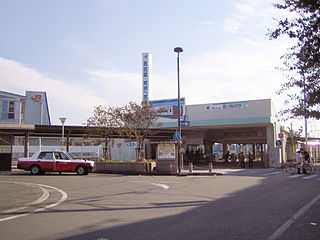
The Hankyu Kyoto Main Line is a railway line in Japan operated by the private railway operator Hankyu Railway. It connects Umeda Station, Osaka and Kawaramachi Station, Kyoto.
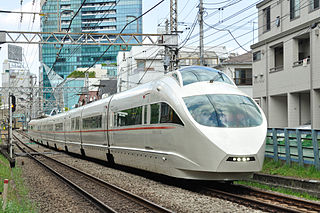
The Odakyu Odawara Line is the main line of Japanese private railway operator Odakyu Electric Railway. It extends 82.5 km from Shinjuku in central Tokyo through the southwest suburbs to the city of Odawara, the gateway to Hakone in Kanagawa Prefecture. It is a busy commuter line and is also known for its "Romancecar" limited express services. From Yoyogi-Uehara Station some trains continue onto the Tokyo Metro Chiyoda Line and beyond to the East Japan Railway Company Joban Line.

The Nagoya Line is a railway line owned and operated by the Kintetsu Railway, a Japanese private railway company, connecting Nagoya and Ise Nakagawa Station in Matsusaka, Mie Prefecture via Kuwana, Yokkaichi, Suzuka, Tsu municipalities along the Ise Bay. The official starting-point of the line is Ise-Nakagawa and the terminus is Nagoya; however, operationally trains run "down" from and "up" towards Nagoya.

The Iida Line is a Japanese railway line connecting Toyohashi Station in Toyohashi, Aichi with Tatsuno Station in Tatsuno, Nagano, operated by Central Japan Railway Company. The line links eastern Aichi Prefecture and southern Nagano Prefecture through northwestern Shizuoka Prefecture. It goes through steep mountains as well as cities such as Iida and Ina. The line was originally four different private railway lines, the first of which opened in 1897.

The Keihan Main Line is a railway line in Japan operated by Keihan Electric Railway. The line runs between Sanjō Station in Kyoto and Yodoyabashi Station in Osaka. There are through services to the Keihan Ōtō Line and the Keihan Nakanoshima Line. Trains from Kyoto to Osaka are treated as "down" trains, and from Osaka to Kyoto as "up" trains.
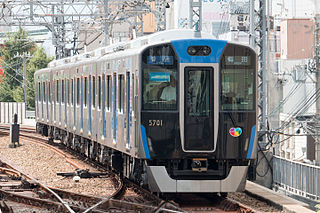
The Hanshin Main Line is a railway line operated by the private railway company Hanshin Electric Railway in Japan. It connects the two cities of Osaka and Kobe, between Umeda and Kobe-Sannomiya stations respectively.
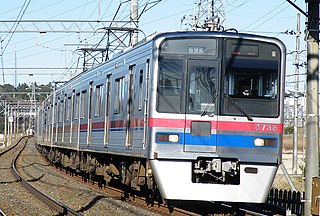
The Keisei Main Line is a railway line of Japanese private railway company Keisei Electric Railway connecting Tokyo and Narita, Japan. It is the main line of Keisei's railway network. Built as an interurban between Tokyo and Narita in early 20th century, the line has served as a main access route to Narita International Airport since 1978. It also serves major cities along the line such as Funabashi, Narashino, and Sakura.

The Keisei Oshiage Line is a railway line in Tokyo, Japan, operated by private railway company Keisei Electric Railway. It connects Oshiage Station in Sumida and Aoto Station in Katsushika.

The Odakyū Enoshima Line is a branch line operated by the Japanese private railway operator Odakyū Electric Railway in eastern Kanagawa Prefecture. The Enoshima Line branches from the Odawara Line at Sagami-Ōno, extending south to Fujisawa and Katase-Enoshima, a distance of 27.6 km. It was completed with 13 stations on April 1, 1929.
The Keikyu Airport Line is a 6.5 km (4.0 mi) commuter line operated in Japan by the private railway operator Keikyu. It connects Keikyu Kamata with Haneda Airport Domestic Terminal in Tokyo, and has Airport Express (エアポート急行), Limited Express and Airport Limited Express (エアポート快特) services, virtually all of which continue along the Keikyu Main Line either north to Shinagawa Station in central Tokyo with some trains continuing onto the Toei Asakusa Line, or south to Yokohama Station and onward towards Shinzushi Station.
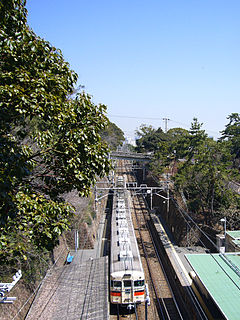
The Sanyo Electric Railway Main Line is a railway line in Japan operated by the private railway operator Sanyo Electric Railway. It stretches from Kobe west to Himeji via Akashi, Kakogawa and other municipalities in Hyōgo Prefecture. The line runs parallel to West Japan Railway Company Sanyo Main Line, with closest sections between Sanyo Suma and Sanyo Akashi stations, and competes with the JR line for its entire stretch.

The Meitetsu Nagoya Main Line or Nagoya Line is a railway line operated by the private railway operator Nagoya Railroad (Meitetsu), connecting Toyohashi Station in Toyohashi with Meitetsu Gifu Station in Gifu.

The Keio Takao line is a railway line operated by the Japanese private railway operator Keio Corporation. The line connects Kitano Station on the Keio Line, to Takaosanguchi Station, and offers access to Mount Takao at the terminal. It is 1,372 mm gauge, electrified at 1,500 V DC. The line originally terminated at Goryōmae to service visitors to the tomb of Emperor Taishō.

The Meitetsu Hiromi Line is a railway line in Japan operated by the private railway operator Nagoya Railroad (Meitetsu). It connects Inuyama Station in Inuyama, Aichi with Mitake Station in Mitake, Gifu.

The Meitetsu Inuyama Line is a 26.8 km Japanese railway line operated by the private railway operator Nagoya Railroad (Meitetsu), which connects Biwajima Junction in Kiyosu, Aichi with Shin-Unuma Station in Kakamigahara, Gifu.

The Meitetsu Tokoname Line is a railway line in Aichi Prefecture, Japan, operated by the private railway operator Nagoya Railroad (Meitetsu), connecting Jingū-mae Station in Nagoya and Tokoname Station in Tokoname.

The Meitetsu Kakamigahara Line is a 17.6 km railway line in Gifu Prefecture, Japan, operated by the private railway operator Nagoya Railroad (Meitetsu), connecting Meitetsu-Gifu Station in the city of Gifu with Shin-Unuma Station in Kakamigahara.
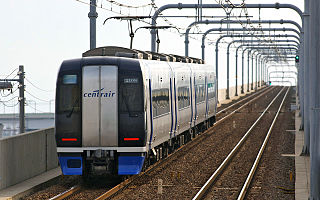
The Meitetsu Airport Line is a railway line in Aichi Prefecture, Japan, operated by the private railway operator Nagoya Railroad (Meitetsu), connecting Tokoname Station and Central Japan International Airport Station in Tokoname. The line opened, dual track and electrified, on 29 January 2005, and features a 1,076 m bridge over Ise Bay to the artificial island where the airport is situated. The line is operated as an extension of the Meitetsu Tokoname Line.
This article incorporates material from the corresponding article in the Japanese Wikipedia.


